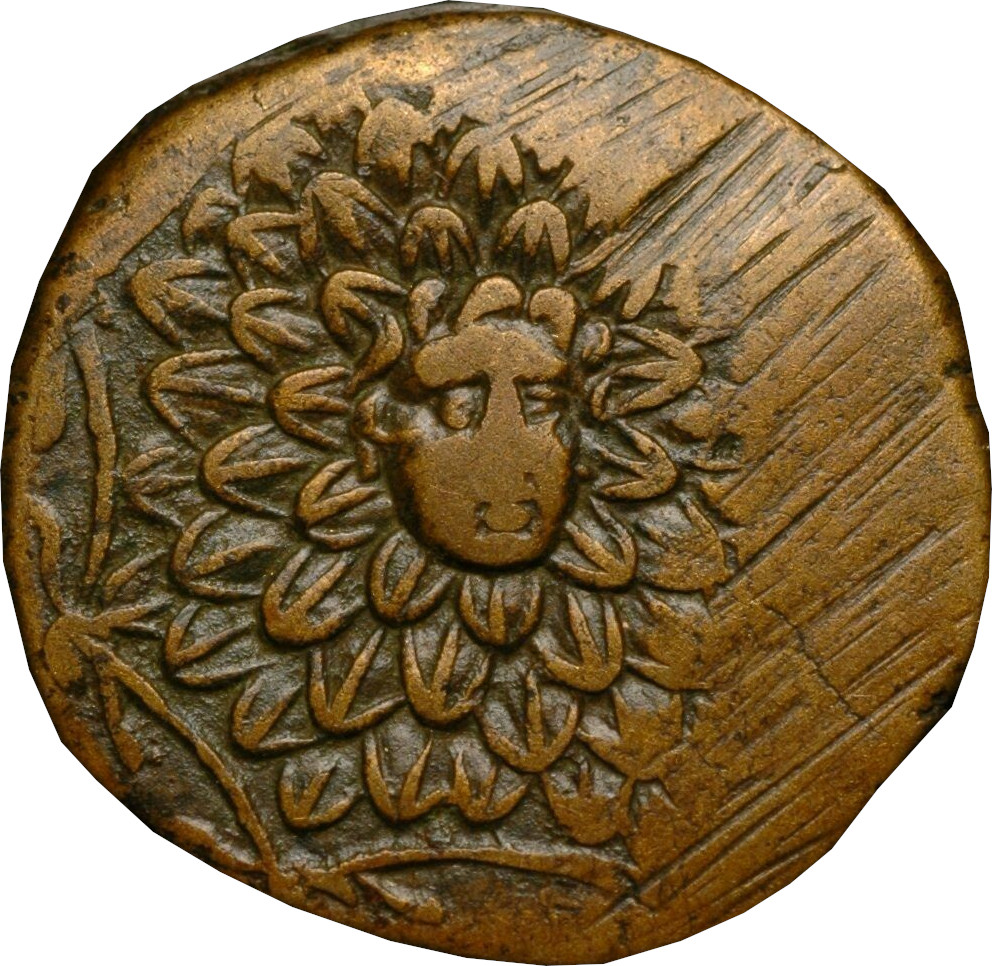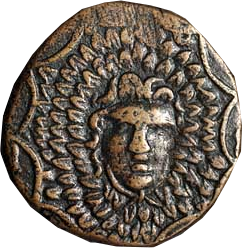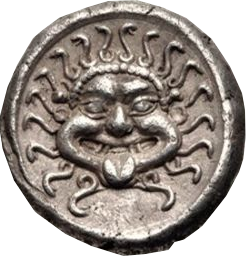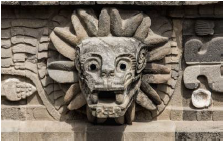Ancient Psychedelia: Alien Gods & Mushroom Goddesses
Online Book - Chapter 11, Page 214
Back to Online Book Mainpage / Next Page (Chapter 11, Page 215)
Other depictions of the “gorgon head” can be seen on several examples of Greek coins during the reign of Mithradates VI, c. 85-65 BC, where we see the gorgon face with mushrooms shooting out from the face, in all directions (49d, i). However, not all the coins of this rulership or era betray this mushroom symbolism (49j).  (49i) Amisos in Pontos Mithradates VI Eupator Aegis facing c. 85 BC  (49j) Sinope in Paphlagonia Mithradates VI, Obverse Gorgon's head in the centre. c. 120-63 BC Ruck sees Perseus as a transitional deity on the path to patrilineality like Ian and Iamos along with Danae being transitional similar to Euadne and Creusa. (235) The Greek concept of the Gorgon of which Medusa is the most famous, as a symbol of death and a monster slain by Perseus, evolved from an early primordial concept of the goddess as both the giver of life and the taker to death. It would be hard to imagine the ancient people deifying one agent for life and a different one for death, so seeing her in her positive functions assumes she has negative connotations as well, not necessarily in the sense of evil, but in a yin/yang type contradistinction in life. It’s also very much possible that the gorgon represents the scariest part of the “near death trip.” This is the moment you go to “hell” and back and it becomes very scary indeed. I remember the first time it happened to me and how the only thing that saved my peace of mind was knowing that it was a trip that I planned and from which I would eventually return. Next time you happen to be having a difficult time on mushrooms or a psychedelic, try looking at an image of the gorgon and ask yourself if this is the image of the devil while you are in hell. You might find it to be. I raise this imagery here because this was a large part of my |
conscious “unfolding” relating to this book and subject matter. The imagery of the gorgon helped me understand that this was part of the “bad trip” (48g). This very same imagery is prevalent in the Mayan and Aztec culture as well when we look at the Pyramid of Quetzalcoatl (feathered serpent), in Teōtīhuacān, Mexico (75e). One has to wonder how the Greeks, far removed in the Mediterranean from the Central American cultures of the Aztecs and Mayans would have the exact same symbolic imagery for this face of “terror” as I like to call it. The best example really is Kali, of the Hindu pantheon.  R: (75e) Pyramid of Quetzalcoatl (feathered serpent) Teōtīhuacān Since she has been historically associated with various deities in both Greek, Aztec and Mayan myth we’ll address these various mythologies. The main one being the Greek gorgon Medusa. The many variations of Medusa have her flanked by cranes and lions or holding cranes or geese in her hands and serpents in her hair oftentimes, all of which associate her with the Lady of the Beasts, the Mistress of Wild Things, or what has become known as the dangerous side of Artemis or Hecate. This has also been characterized by scholars as being the youthful maiden antagonistic to the old hag though I would side with the connection to the dangerous aspect of nature. (236) According to Jose Celdran and Carl Ruck, the caphead or gorgoneion, was originally, the only way the Gorgon Medusa was portrayed, and the anthropomorphized body was a later development. (237) (235) Apples of Apollo, p. 70 (236) Language of the Goddess, p. 278 (237) Mushrooms, Myths and Mithra, p. 95; See Jose Alfredo Gonzales Celdran and Carl Ruck, "Daturas for the Virgin:: 49-74, in Entheos vol. 1, no. 2 (Winter 2001) specifically 68 et seq. |
Go Back to Page 213